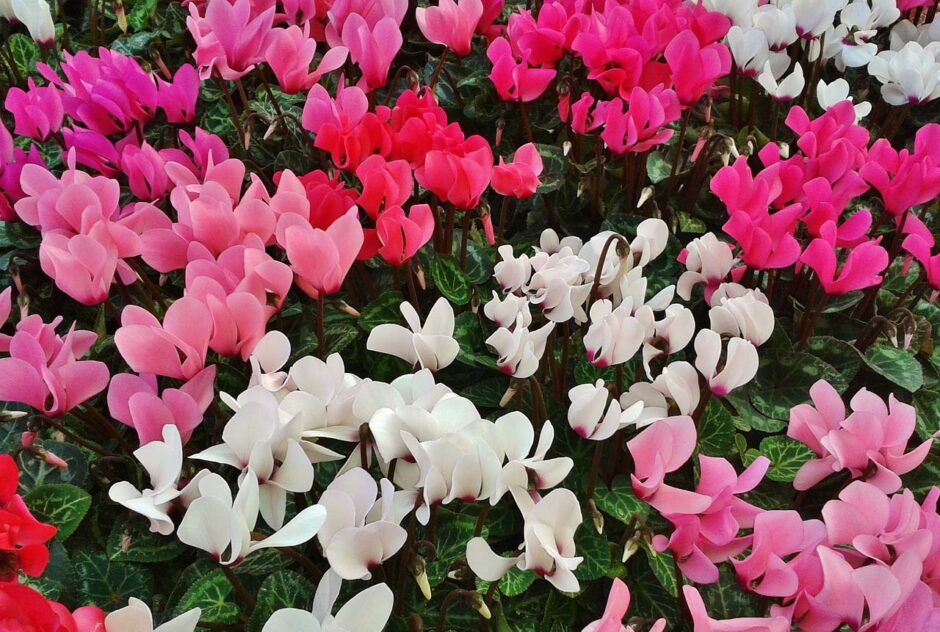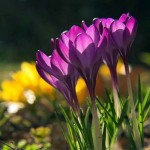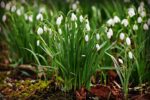
Brighten Up Your Winter with Beautiful Flowers
Winter can feel long and dreary, but it doesn’t have to be devoid of colour. You can have a garden that shines even during the coldest months with proper planning and plant selection. Winter flowers are a great way to brighten up the winter months. Many flowering plants thrive in colder temperatures. Your garden can stay vibrant with pansies, violas, snapdragons, and flowering kale.
Choosing Winter Blooms
The key to creating an eye-catching winter garden is to select plants that either flower or have attractively coloured foliage during the colder months. Cold-hardy perennials, annuals, bulbs, and shrubs can withstand frost and snow. Here are some of the best winter flower options for your landscape:
Pansies & Violas
No other plant quite says “winter” like the pansy. These cheerful flowers are available in a wide variety of solid and multi-coloured colours. The petals are velvety and have “faces” that add personality. Pansies and their smaller cousins, violas, do well in cold weather. They’ll bloom continuously throughout the winter and put on a show of colour in the spring. Use them to decorate beds, borders, containers, and hanging baskets. Viola blooms are also edible!
Flowering Kale & Cabbage
Flowering kale and cabbage add a unique beauty to the vegetable garden. Their leaves form vibrant rosettes in white, pink, red, and purple. Frost causes the plant’s bloom colours to intensify. They make eye-catching accents in pots or garden beds.
Snapdragons
Snapdragons’ snapping “mouths” give them a playful quality, and their flower spikes withstand harsh winter conditions. They are available in a variety of solids and bi-colours ranging from white to yellow to crimson. Snapdragons will overwinter in many climates and reward you with blooms in the early spring as well.
Cyclamen
Cyclamen have elegant nodding flowers in white, red, pink, or purple that are surrounded by round green leaves. They make excellent winter houseplants but can also be grown outside in milder climates. Plant their bulbs in shady areas to enjoy blooms from autumn to spring.
Flowering Shrubs
By including shrubs that bloom in the off-season, you can add vibrant structure to your winter garden. Quince, viburnum, witch hazel, wintersweet, and winter honeysuckle are a few examples. Camellias and other evergreen flowering shrubs add colour when nothing else is blooming.
Caring for Winter Flowers
While winter-blooming plants are tougher than most, they still require some attention to look their best in cold weather. Follow these guidelines to keep your winter garden healthy:
- Pay attention to hardiness zones and select only flowers that are suitable for winter in your area. Choose cold-tolerant annuals or perennials.
- Apply a thick layer of mulch around the base of plants to protect the roots from freezing. Wood chips, straw, or evergreen boughs are all suitable.
- When the soil dries out, thoroughly water it. Less frequent watering promotes deeper roots. However, do not allow pots or beds to completely dry out.
- Examine the drainage and amend the soil to avoid soggy conditions that could rot bulbs or roots.
- To encourage more flowering, remove faded blooms. Deadhead pansies and violas on a regular basis.
- Monitor for pests such as aphids and disease symptoms, and treat any problems as soon as possible.
- Place pots against walls or structures to protect delicate flowers from the wind.
- If hard freezes are expected, cover sensitive blooms with cloches or cold frames.
- Consider planting winter flowers a little closer together than summer flowers in tubs or hanging baskets. This is due to the fact that they will grow more slowly and require fewer nutrients.
With just a little planning and care, you will be rewarded with a vibrant, colourful winter garden!
Ideas for Displaying Winter Flowers
Finding creative ways to display winter blooms in your yard and garden is one of the joys of winter blooms. Here are some ideas for showcasing these plants to their full potential:
Window Boxes & Hanging Baskets
Fill window boxes or hanging baskets with pansies, violas, or trailing ivy for colourful accents near doorways and entrances. Pair purple pansies with chartreuse-yellow violas for a pop of colour. Trailing ivy or flowering kale looks lovely spilling over the basket’s edges.
Pathway Planters
Containers planted with seasonal blooms can be used to line walkways or mark driveway entries. Plant the same plants on both sides of the path to achieve harmony. Alter the colour and texture of planters leading to the front door to add interest.
Winter Porch Pots
Decorate your porch, patio, or deck with cyclamen, ornamental cabbage and kale, snapdragons, and flowering shrubs for the season. For added texture, use evergreen boughs, berries, and pine cones. Containers in complementary or contrasting colours should be grouped together.
Cut Flowers
Many winter plants make beautiful cut flowers, bouquets, and arrangements. To display indoors, cut sprigs of holly, flowering quince, winter jasmine, or hellebore. In glass bowls, float hellebore or anemone blossoms.
Corner Accents
Highlight pots of cyclamen, heather, winter aconites, or flowering aloes in partially shaded garden beds or corners with pockets of sunlight. These eye-catching details will enhance garden strolls.
Fragrance Stops
Along paths and sitting areas, place containers of deliciously fragrant blooms like winter honeysuckle, viburnum, and wintersweet. Brushing against the plants releases their enticing aromas.
With a little imagination, your winter garden can be just as interesting as it is in the spring and summer. The possibilities for showcasing the unique beauty of plants that shine this time of year are endless.
Combining Winter Flowers for Impact
Creating combinations of different plants that complement each other beautifully is one of the most rewarding aspects of gardening. Beautiful winter displays can be created by carefully blending flowers, foliage, and form. Here are some ideas for powerful pairings:
- Contrast the deep purple pansies with the lime green leaves of flowering kale or cabbage for a dramatic effect. Underplant them with white snowdrops.
- Surround a large container of showy pink hellebore flowers with lower pots of delicate snowdrops and diminutive Iris reticulata.
- Alternate blue early-blooming crocus bulbs with clumps of yellow winter aconite corms to create waves of colour.
- Plant a winter window box with fragrant winter honeysuckle vines trailing over the edges and small pots of pink heather tucked among them.
- Pair the fascinating grey twisting stems of witch hazel shrubs with bright sprays of yellow witch hazel flowers and soft mounds of heather beneath.
- Mix white cyclamen, pansies in purple shades, and blue muscari bulbs together in layers for a serene monochromatic display.
- Combine the striking yellow flowers of fothergilla shrubs with pots of red camellia blossoms and dark green conifers like junipers.
Let your imagination run wild when blending winter plants together.
Achieving Winter Curb Appeal
The attractiveness of a home when viewed from the street is referred to as curb appeal. In order to achieve winter curb appeal, plants, lighting, and design accents must be used to create visual interest even during the dormant season. Here are some suggestions for making an excellent first impression this winter:
- Install seasonal containers flanking your entryway filled with colourful blooms, evergreens, and berries. Go big for maximum impact.
- Plant a showy winter garden bed along the front foundation with structure from shrubs and perennials combined with pansies, cabbage, and violas.
- Add accent lighting in trees and along paths to create a welcoming glow during short winter days.
- Frame front walkways or driveways with mini-gardens of cyclamen, rosemary topiaries, ornamental grasses, and large rocks.
- Use decorative features like arbours, obelisks, ironwork, and garden art that look great year-round.
- Include focal points like striking evergreens, contorted deciduous trees, tree-form shrubs, and water features.
- Keep lawns neat and walkways free of debris. Crisp edges and freshly trimmed plants give a tidy look. Remove and compost any leaves that have fallen during the autumn.
- Incorporate winter interest by leaving seed heads on perennials and allowing frost to decorate evergreen foliage.
Don’t resign yourself to a drab winter facade. Some planning and thoughtful plant choices can give your home curb appeal no matter the season!
Enjoying Winter Flowers Indoors
While colour and interest in the garden are wonderful, the beauty of winter blooms can also be brought indoors. During the winter, cutting flowers and forcing bulbs are simple ways to brighten up interior spaces. Here are a few ideas:
- Cut branches of pussy-willow, quince, winter jasmine, and flowering shrubs to display in vases and arrangements.
- Float hellebore and camellia flower heads in glass bowls and containers.
- Force pre-cooled bulbs like hyacinths, crocus, and miniature irises indoors for late-winter blooms.
- Plant prepared hyacinth, narcissus, and amaryllis bulbs in pots for indoor blooming during the winter. Pansies and violas also grow well indoors.
- Make pressed flower art using freeze-dried blossoms from your winter garden. Frame with evergreen clippings.
- Create flower arrangements combining fresh-cut blooms, evergreen boughs, dried seed pods, and bare tree branches for texture.
- Decorate wreaths and mantels with cut branches, complete with winter berries.
Bringing the beauty of your winter garden indoors allows you to enjoy it all year. The bright colours and sweet scents will remind you that winter does not have to be depressing.
Winter flowers can add charm and colour to your garden during the coldest months if you choose the right carefree, cold-hardy plants. Use a variety of flowering annuals, perennials, bulbs, shrubs, and trees to create eye-catching displays. Even as snowflakes fall, your garden can dazzle with floral beauty with just a little time and effort.
For more ideas on selecting and planting winter flowers, please visit the Gardener’s World website.
You may also be interested in this article I wrote a while back on Winter Bedding Plants and Winter Vegetables, as well as general advice for jobs to be doing during winter.



